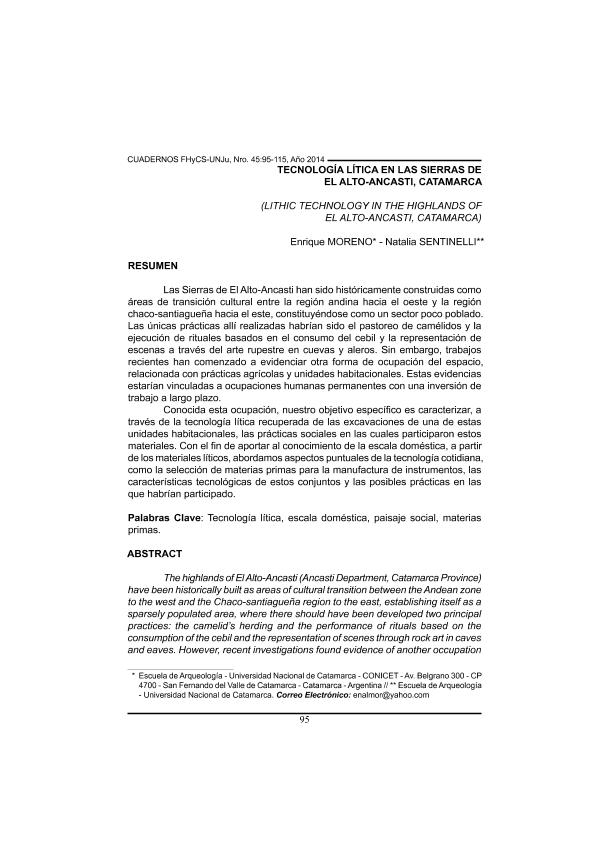Mostrar el registro sencillo del ítem
dc.contributor.author
Moreno, Enrique Alejandro

dc.contributor.author
Sentinelli, Natalia

dc.date.available
2018-05-08T21:17:47Z
dc.date.issued
2014-10
dc.identifier.citation
Moreno, Enrique Alejandro; Sentinelli, Natalia; Tecnología lítica en las sierras de El Alto-Ancasti, Catamarca; Universidad Nacional de Jujuy. Facultad de Humanidades y Ciencias Sociales; Cuadernos de la Facultad de Humanidades y Ciencias Sociales; 45; 10-2014; 95-115
dc.identifier.issn
0327-1471
dc.identifier.uri
http://hdl.handle.net/11336/44542
dc.description.abstract
Las Sierras de El Alto-Ancasti han sido históricamente construidas como áreas de transición cultural entre la región andina hacia el oeste y la región chaco-santiagueña hacia el este, constituyéndose como un sector poco poblado. Las únicas prácticas allí realizadas habrían sido el pastoreo de camélidos y la ejecución de rituales basados en el consumo del cebil y la representación de escenas a través del arte rupestre en cuevas y aleros. Sin embargo, trabajos recientes han comenzado a evidenciar otra forma de ocupación del espacio, relacionada con prácticas agrícolas y unidades habitacionales. Estas evidencias estarían vinculadas a ocupaciones humanas permanentes con una inversión de trabajo a largo plazo. Conocida esta ocupación, nuestro objetivo específico es caracterizar, a través de la tecnología lítica recuperada de las excavaciones de una de estas unidades habitacionales, las prácticas sociales en las cuales participaron estos materiales. Con el fin de aportar al conocimiento de la escala doméstica, a partir de los materiales líticos, abordamos aspectos puntuales de la tecnología cotidiana, como la selección de materias primas para la manufactura de instrumentos, las características tecnológicas de estos conjuntos y las posibles prácticas en las que habrían participado.
dc.description.abstract
The highlands of El Alto-Ancasti (Ancasti Department, Catamarca Province) have been historically built as areas of cultural transition between the Andean zone to the west and the Chaco-santiagueña region to the east, establishing itself as a sparsely populated area, where there should have been developed two principal practices: the camelid’s herding and the performance of rituals based on the consumption of the cebil and the representation of scenes through rock art in caves and eaves. However, recent investigations found evidence of another occupation form of this space, related to agricultural practices and residential units. These evidences would be related to permanent human occupations with a long term work investment. The specific object of this paper is to deepen the domestic scale in this area, specifically regarding practices developed in that place and interpreted through the study of lithic technology recovered from the excavation of two site enclosures El Taco 19 (T19). These materials will allow an approach to the selection of raw materials for the instrument’s manufacturing, as well as the technological characteristics of these sets and the possible practices in which they would have participated.
dc.format
application/pdf
dc.language.iso
spa
dc.publisher
Universidad Nacional de Jujuy. Facultad de Humanidades y Ciencias Sociales

dc.rights
info:eu-repo/semantics/openAccess
dc.rights.uri
https://creativecommons.org/licenses/by-nc-sa/2.5/ar/
dc.subject
Ancasti
dc.subject
Prácticas Sociales
dc.subject
Tecnología
dc.subject
Lítica
dc.subject.classification
Historia

dc.subject.classification
Historia y Arqueología

dc.subject.classification
HUMANIDADES

dc.title
Tecnología lítica en las sierras de El Alto-Ancasti, Catamarca
dc.title
Lithic Technology in the highlands of El Alto-Ancasti, Catamarca
dc.type
info:eu-repo/semantics/article
dc.type
info:ar-repo/semantics/artículo
dc.type
info:eu-repo/semantics/publishedVersion
dc.date.updated
2018-05-08T19:32:48Z
dc.journal.number
45
dc.journal.pagination
95-115
dc.journal.pais
Argentina

dc.description.fil
Fil: Moreno, Enrique Alejandro. Universidad Nacional de Catamarca. Escuela de Arqueología; Argentina. Consejo Nacional de Investigaciones Científicas y Técnicas; Argentina
dc.description.fil
Fil: Sentinelli, Natalia. Universidad Nacional de Catamarca. Escuela de Arqueología; Argentina. Consejo Nacional de Investigaciones Científicas y Técnicas; Argentina
dc.journal.title
Cuadernos de la Facultad de Humanidades y Ciencias Sociales

dc.relation.alternativeid
info:eu-repo/semantics/altIdentifier/url/http://www.redalyc.org/pdf/185/18538243005.pdf
dc.relation.alternativeid
info:eu-repo/semantics/altIdentifier/url/http://revista.fhycs.unju.edu.ar/revistacuadernos/index.php/cuadernos/article/view/147
Archivos asociados
